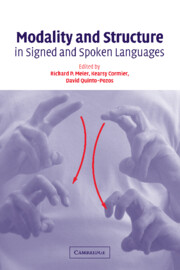Book contents
- Frontmatter
- Contents
- List of figures
- List of tables
- List of contributors
- Acknowledgements
- 1 Why different, why the same? Explaining effects and non-effects of modality upon linguistic structure in sign and speech
- Part I Phonological structure in signed languages
- Part II Gesture and iconicity in sign and speech
- Part III Syntax in sign: Few or no effects of modality
- 10 Where are all the modality effects?
- 11 Applying morphosyntactic and phonological readjustment rules in natural language negation
- 12 Nominal expressions in Hong Kong Sign Language: Does modality make a difference?
- Part IV Using space and describing space: Pronouns, classifiers, and verb agreement
- Index
- References
10 - Where are all the modality effects?
Published online by Cambridge University Press: 22 September 2009
- Frontmatter
- Contents
- List of figures
- List of tables
- List of contributors
- Acknowledgements
- 1 Why different, why the same? Explaining effects and non-effects of modality upon linguistic structure in sign and speech
- Part I Phonological structure in signed languages
- Part II Gesture and iconicity in sign and speech
- Part III Syntax in sign: Few or no effects of modality
- 10 Where are all the modality effects?
- 11 Applying morphosyntactic and phonological readjustment rules in natural language negation
- 12 Nominal expressions in Hong Kong Sign Language: Does modality make a difference?
- Part IV Using space and describing space: Pronouns, classifiers, and verb agreement
- Index
- References
Summary
Introduction
Sign languages are produced and perceived in the visual modality, while spoken languages are produced and perceived in the auditory modality. Does this difference in modality have any effect on the structures of these two types of languages? Much of the research on the structure of sign languages has mentioned this issue, but it is far from resolved. To some authors, the differences between sign languages and spoken languages are paramount, because the study of “modality effects” is a contribution which sign language research uniquely can make. To others, the similarities between sign languages and spoken languages are most important, for they can tell us how certain properties of linguistic systems transcend modality and are, therefore, truly universal. Of course, both of these goals are worthy, and this book is testimony to the fruits that such endeavors can yield.
In this chapter I address the question of modality effects by first examining the architecture of the language faculty. By laying out my assumptions about how language works in the general sense, predictions about the locus of modality effects can be made. I then take up an issue that is a strong candidate for a modality effect: the use of space for indicating reference in pronouns and verbs. I review some of the issues that have been discussed with respect to this phenomenon, and offer an analysis that is in keeping with the theoretical framework set up at the beginning.
- Type
- Chapter
- Information
- Modality and Structure in Signed and Spoken Languages , pp. 241 - 262Publisher: Cambridge University PressPrint publication year: 2002
References
- 10
- Cited by



